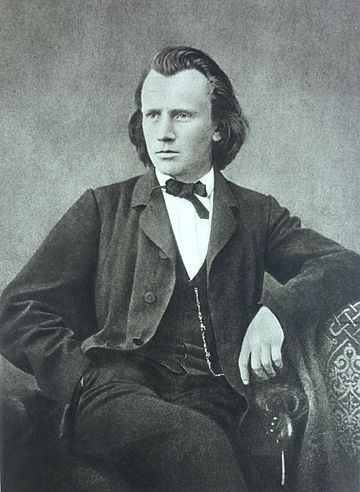A German Requiem facts for kids
Quick facts for kids Ein deutsches RequiemA German Requiem |
|
|---|---|
| Choral composition by Johannes Brahms | |

The composer c. 1866
|
|
| English | A German Requiem, to Words of the Holy Scriptures |
| Full title | Ein deutsches Requiem, nach Worten der heiligen Schrift |
| Catalogue | Op. 45 |
| Text | from the Luther Bible |
| Language | German |
| Composed | 1865–1868 |
| Movements | seven |
| Scoring |
|
A German Requiem is a powerful musical work created by the famous composer Johannes Brahms. It is written for two soloist singers (a soprano and a baritone), a large choir, and a full orchestra. This special piece was first performed in Leipzig, Germany in February 1869.
Contents
What is A German Requiem?
A "requiem" is usually a musical piece written for a funeral or to remember those who have passed away. However, Brahms' A German Requiem is different. It is not a traditional church service for the dead. Instead, it offers comfort and hope to those who are grieving.
Who Was Johannes Brahms?
Johannes Brahms (1833–1897) was a German composer and pianist. He is considered one of the most important musicians of the Romantic period. Brahms wrote many types of music, including symphonies, concertos, chamber music, and choral works. His music is known for being very emotional and carefully crafted.
What Makes This Requiem Different?
Most requiems are based on traditional Latin texts from the Roman Catholic Mass. Brahms chose to use texts from the Luther Bible in German. This is why it is called "A German Requiem." He carefully selected verses that focus on comfort, hope, and the idea of finding peace.
A Message of Comfort and Hope
Brahms wanted his Requiem to be a source of comfort for people who have lost loved ones. He once said that the piece was meant to be a "human" requiem. It speaks to the feelings of sadness and loss, but also offers a message of peace and reassurance. It reminds listeners that there is hope beyond sorrow.
How Is It Performed?
A German Requiem is a large-scale work. It requires many musicians to perform it. The choir sings most of the text, often with powerful harmonies. The soloists add individual voices that express deep emotions.
The Voices and Instruments
- The soprano is a high female voice. In this piece, the soprano solo brings a feeling of gentle comfort.
- The baritone is a middle-range male voice. The baritone solo often sings about human suffering and the need for comfort.
- The mixed choir includes sopranos, altos, tenors, and basses. They sing together to create a rich, full sound.
- The orchestra provides the musical background. It includes string instruments (like violins and cellos), woodwinds (like flutes and clarinets), brass instruments (like trumpets and trombones), and percussion (like timpani).
The Seven Movements
The Requiem is divided into seven parts, called movements. Each movement has a different mood and message.
- The first movement offers comfort to those who mourn.
- Later movements explore themes of human weakness and the hope for eternal peace.
- The fifth movement features the soprano soloist, bringing a tender, motherly comfort.
- The final movement returns to the idea of blessedness and peace.
Why Is It Still Popular Today?
A German Requiem remains one of Brahms' most loved and performed works. Its beautiful melodies and profound message continue to touch audiences around the world. It offers a universal message of comfort and hope that resonates with people of all backgrounds.
See Also
- List of compositions by Johannes Brahms


